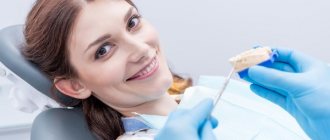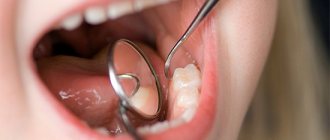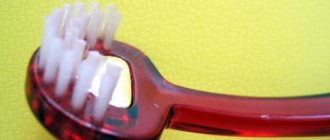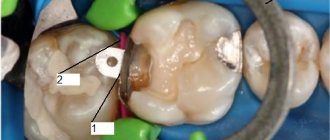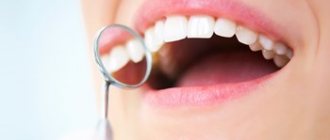Children are more susceptible to caries than adults. This is explained by various reasons: weak immunity, thin enamel, etc. Is it necessary to take preventive measures if baby teeth fall out anyway and permanent ones grow in their place? In this article we will answer this question and tell you what measures can prevent childhood caries.
In this article
- Methods for preventing caries in children
- Prevention of caries in young children
- Prevention of caries in preschool children
- Prevention of caries in school-age children
Caries develops due to the proliferation of cariogenic microbes in the mouth. They are present in the oral cavity of all adults; children can become infected with them from their mother through a kiss, pacifier or food. At the same time, the risk of developing this disease in childhood is quite high. This is due to a number of factors, including:
- Poor oral hygiene. Children brush their teeth reluctantly and poorly, especially if this process is not supervised by adults. Leftover food is a favorable environment for the growth of bacteria. The worse a child’s hygiene is, the more often he or she develops caries.
- Consumption of sweets in large quantities. Cariogenic microorganisms live off carbohydrates, so sweets that children eat very often contribute to the rapid spread of bacteria and the appearance of carious lesions.
- Weak enamel. Milk teeth and newly emerging molars are more vulnerable to bacteria, since their enamel has not yet formed and strengthened. The acids released by microbes quickly corrode the enamel surface and penetrate into the hard tissues of the tooth. Caries develops in children not only more often, but also more rapidly.
- Unformed immunity. A weak immune system cannot fully resist the onslaught of microorganisms.
All these factors indicate that it is imperative to prevent caries in primary teeth. According to doctors, preventive measures can reduce the likelihood of caries affecting molars by 80%. Moreover, by protecting a child from caries, many other dental diseases, as well as pathologies of internal organs, can be prevented.
What is caries in children?
Tooth decay in infants under one year of age is the destruction of mineralized tooth particles caused by the action of acids on the tooth surface produced by plaque bacteria.
An important element of this process is the imbalance between mineralization, which is the calcification of the tooth, and demineralization, literally the loss of tooth structure. Factors and causes involved in the formation of dental caries in young children include:
- bacteria present in dental plaque
- carbohydrates, that is, sugars present in food,
- predisposition of dental tissues to decalcification due to insufficient mineralization,
- composition of saliva, its quantity and ability to deoxidize the contents of the oral cavity
- time of exposure of the above factors to dental tissue.
The process of tooth decay in young children begins with the erosion of tooth enamel. This is a white cavity that does not yet require dental care and may disappear with calcium and fluoride supplements. If adequate caries prevention is not applied at this stage, the deeper tissues of the tooth are affected. Caries in young children can occur on the first tooth that emerges.
Fluoridation of teeth as a method of treating dental caries in young children
In the prevention of caries, cosmetic dentistry also offers the practice of fluoride. In prophylactic doses, fluoride is completely safe for children. Fluoride prevention includes:
- varnishing of teeth, i.e. coating of teeth with fluoride varnish (the procedure is carried out twice a year),
- filling of teeth (fissures and cavities) - intended to protect against the development of caries in young children, it should be carried out immediately after tooth eruption.
Why is it important to prevent the development of the disease?
In 90% of cases, caries of primary teeth occurs in an acute and painful form. Children cannot tolerate toothache, which often occurs with caries and can occur at any time of the day. This is the first reason to take care of effective early prevention. There are others:
- damage to the buds of permanent teeth exposed to milk;
- malocclusions that require orthodontic treatment to correct; speech disorders;
- chronic inflammation of the gums, stomatitis;
- Otitis media, tonsillitis, sinusitis due to bacterial damage.
Strengthening tooth enamel
Well, in order to improve the health of the tooth enamel and dental tissue itself, it is recommended to carry out remineralization therapy and take calcium and fluoride preparations for preventive purposes. It is the fragile, demineralized enamel that provides the basis for the development of caries. However, any use of medications must be approved by a pediatric dentist. Before this, the student must undergo a diagnostic examination. Never self-medicate. Also, be careful when choosing medicated toothpastes. They should also be selected for your child by a pediatric dentist.
Schoolchildren should also have a balanced diet in a special way. Of particular importance are calcium, fluoride and other microelements important for dental health. The intake of these substances both inside the body and the external strengthening of the enamel is of particular importance. Coating teeth with fluoride varnish or special fluoride-containing compounds can be strongly recommended by pediatric dentists at this age. After all, practicing dentists in the field of pediatric dentistry have long noticed that, on average, the eruption of permanent teeth in modern children occurs at an earlier time. The enamel does not have time to quickly strengthen and form, and therefore its strengthening is indicated for almost everyone. At the same time, any action to strengthen the child’s tooth enamel is best carried out under the supervision of a qualified pediatric dentist. This means that before starting strengthening procedures, the doctor will definitely carry out proper teeth cleaning, and then prescribe a comprehensive diagnostic examination and carry out the procedure itself, taking into account all the individual characteristics of the child.
Prevention of caries in children
How to avoid caries in a child? There are simple steps you can take to reduce the likelihood of it occurring.
- Brush your child's teeth as soon as their first teeth appear. At first, you can use sanitary napkins with xylitol.
- Don't lick your baby's pacifiers or let your baby eat from a spoon. This can transfer bacteria from the mouth to the baby and increase the likelihood of tooth decay on newly erupted teeth.
- Avoid giving your baby juices or sugary formulas at night or at bedtime. After your last meal, you need to brush your teeth! If your baby is breastfed, after a year, reduce nighttime feedings; remember that breast milk is also sweet and can cause the development of caries.
- From 1-1.5 years old, regularly visits the pediatric dentist (once every 3-4 months).
- Don't forget about regular oral hygiene at least twice a day for 2-3 minutes.
- Brush your child's teeth yourself until he is 4-5 years old, so be sure to help him with brushing. Until the age of 8-9 years, a child still cannot brush all his teeth correctly, even if he knows how to do it correctly.
- Let your baby's diet be rich in micronutrients. Encourage your child to chew carrots and apples to reduce plaque buildup and strengthen gums.
- Professional oral hygiene is not a luxury, but an extremely useful procedure, because only a dentist can remove hard plaque. Also, if possible, go through the procedures of enamel mineralization and fissure sealing on young permanent teeth with your child. These measures are a good prevention of dental caries in children.
First measures
- Preventing carious lesions is the main task of parents from the moment of pregnancy. Recommendations for antenatal prevention have been developed especially for pregnant women:
- the diet should be complete and include foods containing calcium and phosphorus: cottage cheese, milk, seafood;
- take vitamin preparations according to indications;
- sanitation of the oral cavity during pregnancy, complete elimination of caries in women.
- Children who are bottle-fed are at greater risk of developing caries due to the high likelihood of infection with streptococcus through nipples, bottles, spoons, etc. The best way of prevention up to the age of 6 months is breastfeeding on demand without the use of pacifiers and supplementation. If you use pacifiers and bottles, boil them regularly and do not lick them yourself or let older children lick them.
- Teeth can be affected by caries immediately after they appear, so you need to take care of them immediately after eruption. Wipe your teeth and gums with special dental wipes; for your teeth, you can use a finger brush with soft bristles.
- Do not give juices, compotes, teas, or fermented milk products at bedtime or during sleep. There is a high risk of developing bottle caries. After a year, it is better to give your child water from a cup. Avoid sweet supplements and use only water.
- Do not dip the pacifier in honey, sugary drinks, etc.
Bad habits also have a negative impact on dental health:
- thumb sucking;
- the child bites nails, pens, pencils and other objects.
All this leads to helminthic infestations, malocclusion, increased load on periodontal tissues, chipped enamel and damage to the mucosa. Sucking objects also causes structural defects in the dentofacial apparatus, which subsequently require long-term treatment. You should distract the child, gently correct the behavior and prevent it.
Another common problem is “chewing laziness,” when a child only accepts soft, pureed foods. Refusal of pieces and hard foods leads to weakness of periodontal tissues, abnormal bite, and a high risk of developing caries. Soft food reduces the quality of self-cleaning of the mouth, the amount of plaque increases, leading to softening of the enamel and the appearance of foci of infection.
Deep fluoridation
Fluoride is known to be an important element in maintaining dental health. However, until recently, the only way to replenish this element in the enamel was toothpaste with fluoride. But its effectiveness is very low, and teeth are still susceptible to destruction. The lack of fluoride is especially felt by residents of those regions where there is a lack of it in drinking water and food.
Today, medicine offers a unique method for restoring tooth enamel and hard tooth tissues - deep fluoridation. This procedure replenishes mineral deficiencies, reduces tooth sensitivity and prevents the growth of bacteria that leads to tooth decay. For children, deep fluoridation is of particular importance, since the formation of permanent teeth occurs only in the child’s body. Insufficient intake of fluoride from food and irregular oral care can contribute to the premature destruction of tooth enamel. Using the deep fluoridation procedure, you can increase its hardness by 10 times!
What is the deep fluoridation method?
This method is based on a series of chemical reactions: they produce microcrystals of calcium fluoride that fill microcracks in the enamel. The deep fluoridation procedure itself takes place in several successive stages. First, the dentist brushes your teeth with a special paste to remove plaque and tartar. Then, using a jet of air, the teeth are dried and covered with a filling liquid, which “seals” the enamel (highly dispersed calcium fluoride and magnesium fluoride). After this, drying is carried out again and calcium and copper hydroxide are applied. A chemical reaction occurs between the first and second layers, during which microparticles of calcium fluoride are released, which very easily penetrate into the deep layers of enamel. At the same time, copper compounds formed as a result of the reaction have a strong bactericidal effect. Due to the described interaction of elements, anti-caries protection occurs.
When is deep fluoridation recommended?
This procedure is preventative and completely painless. It is aimed at long-term protection against enamel destruction and caries (the effect lasts up to two years). Therefore, it can be recommended to everyone who cares about dental health.
Deep fluoridation is especially useful in the following cases:
- to protect baby teeth in young children
- for teenagers whose bodies undergo changes associated with puberty, during which caries activity increases
- with fluoride deficiency due to poor diet or natural environment
- with increased tooth sensitivity
- with thinning enamel
- before installation and after removing braces
Due to the fact that the effect of deep fluoridation is quite long-lasting, it is enough to undergo the procedure 1-2 times a year. However, despite the obvious benefits of this preventive measure, we should not forget about other ways to take care of dental health: a balanced diet, regular brushing, regular visits to the dentist, and so on.
Oral hygiene
Individual hygiene procedures are exogenous methods of prevention. It is imperative to monitor the quality and condition of the brushes, follow the correct cleaning technique and do it regularly. It is advisable to use rinses, irrigators and dental floss as additional care methods.
Pastes for caries prevention
At home, you can use compounds that have therapeutic and preventive effects. When used daily, they compact the enamel, remove soft plaque and prevent the growth of harmful bacteria.
Fluorinated
Such pastes contain active amino fluoride. The action of this component is based on the natural mechanisms of fluoride, which is independently integrated into the enamel layer and prevents the leaching of calcium. Using these cleansers twice a day reduces the likelihood of developing the disease by 50%.
Without its content
Drinking water contains a certain amount of fluoride. If the indicators are within normal limits, then the enamel is independently saturated with this mineral. To maintain health, 1.2 mg/l is enough. In such situations, fluoride-free toothpastes are used to prevent dental caries in adults. They contain large amounts of calcium and also have an antibacterial effect. Used for everyday hygiene 2 times a day.
Dental floss
Unlike other products, it is able to remove food debris in the interdental spaces. These areas are inaccessible to brushes, so this is where problems most often arise. Fibers of synthetic or natural origin are used for manufacturing. To achieve maximum effect, the thread is impregnated with special solutions containing fluorides or antimicrobial components. It is advisable to use it after every snack or at least in the evening before brushing your teeth.
Mouth rinses
To further strengthen the protection, fluoride-based solutions are used at home, which have an anti-caries effect. They neutralize the aggressive effects of acid, which destroys enamel, and also prevent the proliferation of pathogens. Experts recommend rinsing your mouth with these products after each meal, as well as before bed.
Toothpicks
These devices are not an effective measure. They are used as an alternative when you don't have a brush or floss to hand to get rid of food stuck between your teeth. Doctors recommend giving preference to plastic or wooden products. Toothpicks must have a smooth surface without chips or cracks. Make sure that the end is slightly rounded, otherwise you may damage your gums.
Other methods for preventing childhood caries
- Remineralizing therapy - restoration of the mineral composition of the enamel, restoration of its original strength and additional strengthening. The essence of the technique is reusable treatment of the tooth surface with a special gel or paste. Remineralizing compounds are characterized by a high concentration of phosphorus, calcium and other components beneficial to dental health that improve the structure of the enamel of primary teeth. Remineralization is carried out in a dental clinic, then dental treatment is carried out at home according to prescriptions recommended by the doctor.
- Silver plating is an outdated technique, but is still popular in many Moscow clinics. Lack of treatment - darkening of teeth, loss of aesthetics. The essence of the method is to coat the enamel with a 30% solution of silver nitrate, which ensures the destruction of bacterial microflora and stops the destruction of the tooth crown.
- Ozone therapy is a non-contact treatment for young children based on the antibacterial effect of ozone. Gentle tooth disinfection at an early stage stops the formation of a carious cavity with subsequent restoration of the enamel with remineralizing compounds.
- ICON technology is a modern method of caries treatment without a drill. The idea is to treat the problem area with a special gel that penetrates deeply into the tooth tissue, destroys bacteria and seals the enamel.
- ART method: painless and gentle manual cleaning of a carious cavity with subsequent installation of a filling.
To make an appointment with a doctor
- home
- Symptoms
- Bad breath
- Caries. etiology, stages of development, prevention
Treatment and prevention of caries
Caries is a pathological process in the oral cavity consisting of demineralization followed by destruction of hard tooth tissues and the formation of a defect under the influence of cariogenic microflora. In other words, caries is a process of tooth destruction associated with the erosion of the mineral substances that form the enamel under the influence of microorganisms and the formation of a void. The process of destruction of enamel occurs gradually: bacteria located in the oral cavity, “digesting” food rich in carbohydrates, release a huge amount of organic acids that contribute to the destruction of apatite crystals, a constituent element of enamel. Next, the microbes penetrate into the deeper layers of the tooth, provoking the development of destructive processes.
Causes leading to caries:
- poor nutrition with a predominance of carbohydrate foods
- the presence of microbes due to inadequate oral care
- insufficient content of vitamins, minerals, proteins, fluorine and other microelements in the body
- hereditary factor
- state of the dental system during the period of formation, development and eruption
Caries has several stages of development:
- Spot stage. This stage is characterized by the absence of any sensations on the part of the patient and is detected during a routine examination of the oral cavity.
- Superficial caries. This stage is characterized by the presence of roughness of the tooth surface and short-term pain when exposed to mechanical or temperature stimuli.
- Medium caries is characterized by the formation of a carious cavity.
- Deep caries is characterized by the occurrence of painful sensations when touching the formed carious cavity. Deep caries is a borderline condition of pulpitis.
Caries therapy, depending on the stage of development of this disease, has a number of nuances. Thus, the stain stage requires remineralization - restoration of a sufficient amount of minerals through the use of special solutions. The remaining 3 stages of the disease require treatment of the carious cavity followed by filling it.
Preventive measures to prevent the occurrence of caries include:
- balanced nutrition with its correction towards increasing the consumption of vitamin-mineral complexes and protein foods instead of carbohydrates;
- proper hygienic care of the oral cavity;
- regular (at least once every six months) visits to the dentist.
The relevance of seeking dental services
An oral examination is an important part of an initial visit to the dentist. It is during this procedure that all oral defects, the prevalence and intensity of dental diseases, the effectiveness of treatment of oral diseases (if any), the level of quality of hygiene and the need for therapy are identified, based on the individual characteristics of the body, methods and therapeutic treatment regimens. An initial appointment with a dentist allows you to create an individual program of treatment and preventive measures for each patient, taking into account the characteristics of oral diseases and the patient’s capabilities. Examination is an integral part of diagnosis and a preventive measure for the development of the pathological process. In this regard, it is necessary to make it a rule to visit the dentist once every six months in order to maintain oral health at the proper level.
Theories of caries occurrence
Dental caries is a pathological process associated with demineralization and softening of the hard tissues of the tooth, leading to the formation of a hole in the tooth. Many factors play a huge role in the occurrence of caries. In particular, the development of the disease is influenced by the quantity and quality of saliva, the quality factor of food and drinking water, hereditary factors and the conditions for the formation of enamel.
There are several theories about the occurrence of caries.
- Chemical-parasitic, discovered in 1884 by Miller, which was subsequently laid as the basis for the modern concept. The pathogenesis of the disease in this theory consists of 2 stages, consisting of the gradual destruction of inorganic substances of enamel and dentin under the influence of lactic acid in excess produced as a result of fermentation of carbohydrate food residues with the transition of destructive processes to the organic substances of dentin under the influence of proteolytic enzymes of microorganisms.
- Physico-chemical, discovered in 1928 by Entin, which considers the theory of the occurrence of caries on the basis of the physico-chemical properties of the tooth and saliva. This theory is based on the study of the direction of movement of osmotic currents of 2 media: blood inside the tooth and saliva outside it. This theory makes it possible to actively use in practice methods of exogenous prevention and treatment of caries in the spot stage.
- Biological, discovered in 1948 by Lukomsky, which is based on the importance of endogenous factors affecting tooth development, such as: tooth vitaminization, the ratio of salts Ca, P and F, the amount of ultraviolet radiation. The lack or absence of these factors leads to disruption of mineral and protein metabolism, and, consequently, tooth destruction. The theory did not find experimental confirmation and was declared untenable.
- Proteolysis-chelation, discovered in 1956 by Schatz and Martin. According to this theory, which has many weaknesses (lack of protein breakdown in the stain stage, lack of connection between the localization of caries and the occurrence of the process, and lack of explanation of the frequency of damage to certain parts of the tooth), the susceptibility of enamel to caries damage is explained by the instability of calcium-protein complexes.
- The trophoneurotic theory, discovered by Platonov, which is based on a violation of the nervous regulation of the tooth, has today confirmed its inconsistency by the fact of the normal functioning of a tooth with removed pulp for up to 17 years.
- The modern concept refers to the appearance of caries as a polyetiological disease, which, based on its occurrence, contains a number of reasons: the state of the microflora of the oral cavity, the nature and diet with the percentage of fluoride in food and water, the qualitative and quantitative composition of saliva, the general condition of the body and resistance to extreme influences.
Cariogenic situation in the oral cavity. Factors, clinic
The caries situation in the oral cavity makes the tooth more susceptible to the effects of acids and is characterized by a decrease in the resistance of dental tissues. The cariogenic situation in the oral cavity is caused by a number of local and general reasons.
Common factors include:
- Quality of drinking water and food
- The presence of somatic diseases and changes in the functional state of organs and systems during the formation and maturation of teeth
- Hereditary factor
Local factors include:
- Presence of dental plaque and plaque
- Violation of the qualitative composition of oral fluid
- Presence of food residues in the mouth
- Increased sensitivity of dental tissue associated with deviations in the biochemical composition
- The state of the dental system during the period of formation and eruption of teeth
The cariogenic situation is manifested in the following symptoms:
- Presence of abundant plaque and tartar
- Dental defects such as crowding or malocclusion
- Bleeding gums.
Prevention of a cariogenic situation is ensured by:
- presence of pellicle
- optimal chemical composition of dental tissues, saliva with its mineralizing activity
- quantitative composition of oral fluid
- permeability of tooth enamel
- uniform distribution of chewing load
- cleaning the surface of the teeth with careful oral hygiene, the presence of plaque, tartar
- full maturation of the tooth during its formation and formation.
Mechanism of caries development
Due to the frequent consumption of carbohydrate foods with insufficient oral hygiene, microorganisms have the ability to fix on the pellicle with the formation of dental plaque. Sticky food promotes hardening of this substance in pits, fillings, dentures, fissures, followed by fermentation and rotting. The soft porous structure of dental plaque quickly turns into dental plaque due to the accumulation of end products of microorganisms in it, under which organic acids accumulate in fairly large quantities, affecting the demineralization of the dental area. In addition, dental plaque contains streptococci, which, in turn, contribute to the rapid development of the pathological process.
The formation of dental plaque depends on:
- anatomical structure of the tooth, the structure of its surface
- diet and chewing intensity
- qualitative and quantitative composition of saliva and gingival fluid
- oral hygiene
- the presence of fillings, dentures, dental anomalies.
The formation of dental plaque depends on:
- food composition (eating soft foods and large amounts of sugar accelerates its development)
- salivation and mechanical impact (during sleep, a plaque forms faster than during eating)
Plaque microorganisms produce heteropolysaccharides that have a negative effect on tooth enamel:
Glycans help bacteria adhere to each other and the tooth surface, causing plaque to thicken
levans and dextrans are recognized as sources of a large number of organic acids that cause demineralization processes.
Multiple caries leads to excessive activity of streptococci and lactobacilli with high enzymatic activity of microorganisms, which is a cariogenic situation.
Clinical picture of caries
Classification of caries plays an important role in determining the clinical picture and choosing treatment tactics for the disease.
Caries classification:
- By location: in the spot stage, superficial, medium, deep
- According to anatomical characteristics: caries of enamel, dentin and cementum of the tooth root
- By localization: fissure, cervical, approximal
- Downstream: slow (fast) flowing, stabilized
- According to process activity: compensated, sub(de)compensated.
Initial caries, in other words, the stain stage is characterized by complaints of a sore throat. The tooth does not respond to any other irritants. Demineralization is manifested in the formation of a stain, which is detected during examination by a dentist. Loss of enamel shine, changes in the tooth surface, methylene blue coloring and quenching of luminescence when exposed to ultraviolet light are signs of caries at this stage.
Superficial caries is characterized by pain in response to various types of short-term stimuli. Examination of the tooth reveals a minor defect in the enamel, manifested by the roughness of its surface and the presence of a stain. Superficial caries can be accompanied by inflammation of the periodontal papilla, manifested in swelling, hyperemia and bleeding of the gums. To diagnose superficial caries, in addition to examination, complementary examination methods are recognized: repeated examinations after 3–6 months, translumination, electroodontodiagnostics and x-rays.
Average caries is characterized by pain in response to irritants of any origin, which disappears after the irritating factor is canceled. The integrity of the enamel-dentin junction is disrupted and a small carious cavity is formed, filled with softened dentin. The acute or chronic course of this pathological process is determined by the shape of the cavity, the entrance hole into it and the presence of dentin.
Deep caries is characterized by painful sensations to various irritants. Examination reveals a deep carious cavity with overhanging enamel edges and softened pigmented dentin inside. Diagnostically, deep caries is revealed by pain during probing and percussion (tapping) of the tooth.
Diet for the prevention of caries in children
Caries bacteria feed on sugar: glucose, fructose or sucrose. Sweets are the main ally of this disease. Although children love them, they should not overuse them. Sugar in desserts not only contributes to the development of tooth decay. It also includes refined carbohydrates such as white sugar, flour and processed foods. The following methods should be followed: dental caries in children
- Eliminate sugar from your diet.
- Replacing colored drinks with water.
- Avoid processed foods.
- Refusal of products containing preservatives.
It often happens that the child drinks colored and carbonated drinks, eats cookies, chips, lollipops or candies as a snack, and drinks milk or cocoa before bed. All of these everyday activities can lead to tooth decay in young children. To prevent serious illness, which is unfortunately not getting enough attention, you need to choose healthier alternatives to popular snacks, sweets and drinks.
The correct level of minerals and nutrients, the dose of vitamins, the rational dosage of sugars and the solid consistency of food are factors that can effectively prevent the formation and development of dental caries in young children. Doctors are confident that every child will be grateful to their parents for developing good habits, proper oral hygiene and diet, which affects the life and health of children not only now, but also in the future.
To prevent caries treatment in young children, it is worth conducting a preventive dental examination every 6 months and removing tartar. Children should be constantly encouraged to prevent tooth decay because it is easier to prevent than to cure, especially when it hurts, and visits to the dentist are frequent and unpleasant for the child.
Types of prevention
Preventive measures are divided into primary and secondary. Primary prevention of caries is measures taken to prevent the disease, eliminate all provoking factors and causes of its development. It can be endogenous (general) and exogenous (local). The goal of the secondary set of preventive measures is to diagnose the disease at an early stage and prevent relapse.
Exogenous methods
Exogenous prevention of caries development includes methods that increase the resistance of the enamel layer to various cariogenic factors:
- Thorough
oral hygiene - Fluoridation
- the use of pastes, gels, solutions containing fluorine, calcium, phosphorus. Applications, physiotherapeutic procedures with remineralizing, fluoride compounds. Toothpaste for the prevention of caries, in addition to hygienic cleaning, provides additional mineralization of the enamel, increasing its protection, reducing the risk of disease. - Regular prof.
examinations - even in the absence of visible signs of carious lesions, you need to undergo a dental examination twice a year. This will help detect the problem at an early stage and quickly eliminate it without resorting to complex treatment or drastic measures. - Professional hygiene
– removal of dental plaque (plaque, stone) in a dental office. - Sealing fissures
with polymer compounds.
Molars and premolars of both jaws are more susceptible to carious lesions, with the lesion predominantly localized on the chewing surface (in fissures, blind foramina, folds). Obturation (sealing) of fissures and other anatomical recesses of the tooth with adhesive materials creates a physical barrier that prevents the penetration of pathogenic microorganisms and organic acids that destroy dental structures into the retention areas of the enamel. The method is aimed at preventing caries of temporary and permanent teeth. The procedure is painless, the effect lasts 3-5 years
.
Endogenous methods
Endogenous prevention of caries in adults can be medicinal (medicinal) and non-medicinal:
- Non-drug measures
involve dietary correction and a healthy lifestyle. Dental health is harmed by smoking, constant consumption of sweets, baked goods, and alcohol. It is recommended to give up bad habits and replace sweets and simple carbohydrates with berries and fruits. The diet should be balanced in the content of proteins, fats, carbohydrates, vitamins, essential minerals, and trace elements. - Drug prevention
includes taking fluoride-containing drugs, vitamin complexes, and nutritional supplements in age-specific dosages. The dentist selects medications for the prevention of caries individually, based on the condition of the teeth and general health.
Comprehensive prevention of dental caries includes a balanced diet, careful hygiene, and regular dental examinations. Even if a person brushes his teeth diligently, but abuses smoking or cannot go a day without sweets, he creates favorable conditions for the proliferation of cariogenic bacteria. Dental health needs to be taken care of as a whole. Can tooth decay be cured with toothpaste? No! But it is necessary to use it to prevent disease.
How to choose toothpaste for a child
Since young children often swallow toothpaste, and sometimes even eat it secretly from their parents, the composition of the toothpaste must be extremely safe for health. Unlike adults, infants do not need large amounts of fluoride, so a child's first toothpaste should not contain fluoride. You should be aware that excessive consumption of fluoride, especially if it is constantly ingested, can lead to damage to tooth enamel and the development of fluorosis.
For preschool children, you can purchase toothpastes with a minimal fluoride content, but in fact, toothpastes with fluoride are recommended only for adults whose teeth have already been fully formed.
A set of measures to preserve dental health
First of all, the prevention of dental caries in school-age children consists of a set of measures aimed, on the one hand, at eliminating risk factors for the occurrence of caries itself, and on the other hand, a series of measures to strengthen and mineralize dental tissue. An important factor in preventing caries will be strengthening the overall health of the student’s entire body. Physical education, healthy eating, good sleep, walks in the fresh air - all these are components of a full healthy lifestyle. At the same time, health education and hygienic education at school age is very important.



